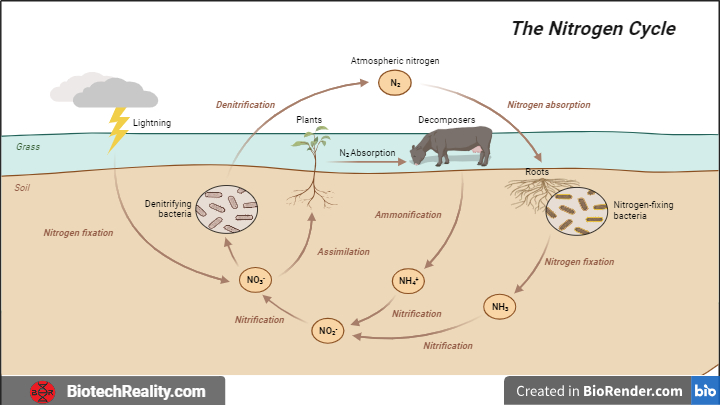The conversion of atmospheric nitrogen gas (N2) into ammonia (NH3) or other molecules that may be utilised as a source of nitrogen by plants and other organisms is known as nitrogen fixation, and it is a biological and chemical process.
Although most plants and animals cannot directly utilise atmospheric nitrogen, it makes up around 78% of the Earth’s atmosphere. Because these substances are more easily absorbed and used, they rely on nitrogen molecules like ammonia, nitrate (NO3-), and nitrite (NO2-) to supply their nitrogen demands.
Nitrogen fixation – Metabolism
Plants uptake nitrogen as their major source of nutrients, hence nitrogen assimilation is one of the most important metabolic pathways in plants. Nitrogen metabolism is needed for various purposes such as, for biosynthesis of amino acids, proteins, nucleic acids, hormones, vitamins etc. Plants absorb the nitrogen from the atmosphere, which is present as nitrogen molecule N2 which is exceptionally stable as it contains a triple covalent bond and by breaking this bond the plants can absorb nitrogen in the form of nitrate NO3– or ammonium NH4+.
The breaking of N2 can be done in two ways,
1. Haber’s process
2. Natural process
1. Haber’s process
It is the industrial process of breaking N2 and the chemical formula is,
2 N2 +2 H2 <———> 2 NH3
The process is done at 200atm pressure and 200°C temperature with iron as a catalyst.
2. Natural process
Natural processes can be of different types that include,
- Lightening
- Photochemical reaction
- Biological Nitrogen fixation
Lightening
During lightening the water vapour and O2 are converted to highly reactive OH free radicals, free oxygen, and hydrogen atoms, and these break the bond of N2 it is then converted into nitric acid (HNO3) and combines with rain water and comes to the soil as acid rain. In the soil, the HNO3 breaks into H+ and NO3-. Plant root contains H+ / NO3– symport through which the plant absorbs it and the assimilation is done by various enzymes present in the plant.
Photochemical reaction
Fixes only 2% of nitrogen. The photochemical reaction between gaseous nitric oxide (NO) and ozone (O3) gives rise to HNO3 and then it combines with rain water and comes to soil as acid rain. In the soil, the HNO3 breaks into H+ and NO3-. Plant root contains H+ / NO3– symport through which the plant absorbs it and the assimilation is done by various enzymes present in the plant.
Enzymes for nitrogen assimilation
There are seven different enzymes are involved in this,
- Nitrate reductase – seen in root cytoplasm, converts nitrate to nitrite
- Nitrite reductase – seen in chloroplast, converts nitrite to ammonium
- Glutamine synthetase – seen in root cytoplasm as well as in chloroplast
- Glutamate synthase – seen in root plastid (NADH GOGAT) as well as in shoot chloroplast (Fd-GOGAT)
- Glutamate dehydrogenase – seen in mitochondria (NADH-GDH) as well as chloroplast (NADPH-GDH)
- Aspartate aminotransferase – seen in cytoplasm, mitochondria, chloroplast, peroxisome and glyoxysome
- Asparagine synthetase
Biological nitrogen fixation
Biological nitrogen fixation is done by different bacteria, both free-living and symbiotic bacteria are involved and 16 ATPs are required for this process. The process includes ammonification, nitrification and then assimilation.
The free-living bacteria convert the atmospheric N2 to ammonium by the ammonification process by the enzyme nitrogenase and the nitrification bacteria such as Nitrosomonas, convert NH4+ to NO2– and Nitrobacter converts NO2– to NO3– and then by H+ / NO3– symport the NO3– is absorbed by the plant from the soil and the assimilation is done by same assimilation enzymes.
But the case is different for symbiotic bacteria, they are present in the plant like a symbiotic association with its roots and the special cells in which the ammonification occurs are called as the root nodules hence by symbiotic nitrogen fixation the plant can absorb NH4+ directly.
Nitrogenase enzyme: the enzyme that is involved in the ammonification process of biological nitrogen fixation, It has three different cofactors, vanadium, iron and molybdenum. It is a multimeric protein complex with two subunits,
- Iron (Fe) part: also called as dinitrogen reductase and is a homodimer and smaller in size about 30-72KDa
- Molybdenum- iron part (Mo-Fe): also called as di-nitrogenase, which is heterotetrameric and larger in size about 180-235KDa and is considered as the site of N2 fixation.
The enzyme is highly sensitive to oxygen because in the presence of oxygen, as it is highly electronegative, it can bind to the electrons in the catalytic site, hence the ammonification process has to be carried out only in anaerobic conditions.
Symbiotic nitrogen fixation
The ammonification process here occurs in the root nodules and the genes present in plants for root nodule formation are called the nodulin genes and those present in bacteria are called the nodulation or nod genes. The nod genes can be classified into two common nod genes and host-specific nod genes. The common nod genes are nod D (constitutively active), nod C, nod B and nod A. The host-specific nod genes are nod P, nod Q, nod E, nod F, nod L, and nod H.
Each gene corresponds to a protein,
| Gene | Protein |
| nod D | Nod D |
| nod C | Nod C – Chitin oligosaccharide synthase |
| nod B | Nod B – Chitin oligosaccharide deacetylase |
| nod A | Nod A – N-acyl transferase |
Formation of root nodule
During nitrogen starvation for the formation of root nodules, the plant releases secondary metabolites such as isoflavonoids or betaines in order to attract bacteria. Then the bacterial nod D receives this signal and produces the Nod D protein and it binds to the nod D box and activates other nod genes. The Nod C activates and synthesizes chitin oligosaccharide by combining N-acetyl D-glucosamine monomers through β-1,4 linkage. The Nod B activates and removes acetyl groups from the chitin oligosaccharide. In the area where the acetyl group are removed, the Nod A adds fatty acyl groups to those regions. The overall structure now obtained is called nod factors or MAMP (microbe-associated molecular pattern) and is formed inside the bacteria.
MAMP acts as a ligand that binds to the receptor in the plant called as leucine-rich repeats (LRR). During the binding the amount of calcium increases in plants. At the same time, the fusion of Golgi-derived vesicles occurs forming the infection threads. Cyclops an unknown protein is also present during the increase of calcium.
Depending on the type of host the MAMPs can be modified and this is done by the host-specific nod genes. The nod E and nod F determines the length and degree of saturation of fatty acyl groups and nod L adds extra sugar molecule to the fatty acyl chain.
The curling of the root hair occurs and after that the wall of the root hair should be broken for the entry of bacteria and it is done by bacteria itself by producing cellulase, hemicellulose and pectinase. At this time the infection thread is formed through which the bacteria enter the cortical region of the root. That particular cortical in which the bacteria are present is called as the root primordium and a membrane is formed around the bacteria and is called the peribacteroid membrane in this cell the bacteria replicate continuously and such cells are called symbiosomes.
At a particular point, reaches a fixed number of bacteria and then the plant gives the signal to stop the replication and start nitrogen fixation. Then the bacteria differentiate for nitrogen fixation and are then called as the bacteroid and such cells ready for nitrogen fixation is called the root nodule. The leghaemoglobin provides the anaerobic condition for nitrogen fixation by scavenging the oxygen in the root nodule.
Author: Neethu Krishna
Published: 04-September-2023
Updated:
Qualified CSIR - National Eligibility Test (NET), eligible for Assistant Professorship in any Indian university. Graduated from the University of Kerala with B.Sc. Botany and Biotechnology. Attained Post-Graduation in Biotechnology from the Kerala University of Fisheries and Ocean Science (KUFOS) with the fourth rank. Conducted various seminars and presentations. Experienced in ELISA, Blotting, and other Good Laboratory Practices. Attended a certificate course in Patent Analytics. Done 6 months of internship in ICMR - Vector Control Research Center, Puducherry. 3 years of tutoring experience.






